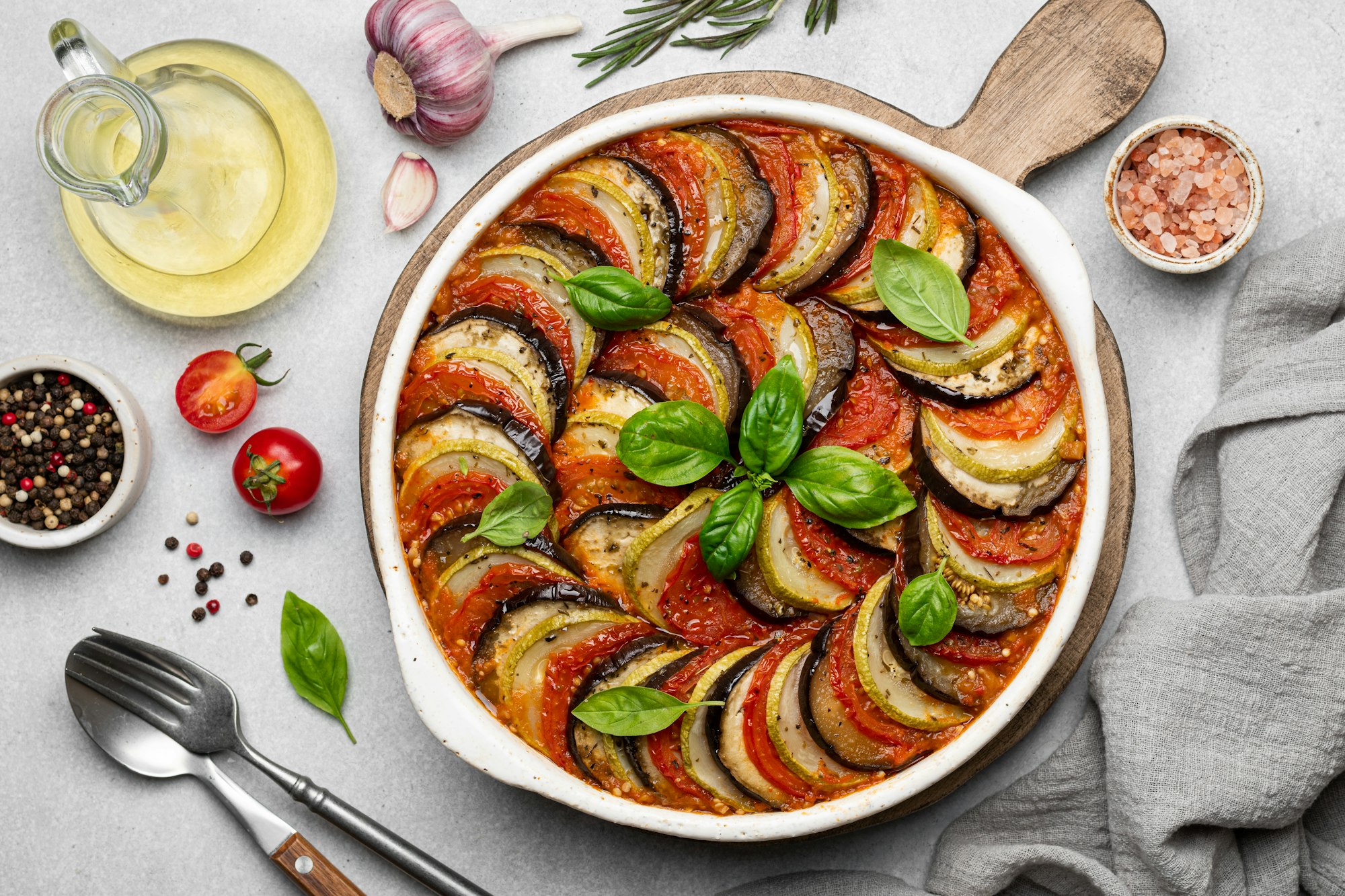Ratatouille, a classic French dish, is a symphony of fresh vegetables, sautéed to perfection, and layered in a rich sauce. It’s a testament to the art of cooking with vegetables, making them the star of the show rather than a mere side dish. But what are the secrets behind a perfectly layered gourmet ratatouille? Today, we delve into the world of gourmet ratatouille, sharing the most effective ways to prepare this delectable dish.
Choosing the Right Ingredients
Your ratatouille begins where all great dishes should: at the market. The ingredients you select will greatly determine the final result, so it’s essential to be picky.
Dans le meme genre : How to Make a Gourmet Lobster Mac and Cheese with a Crunchy Panko Topping?
The classic ratatouille ingredients include eggplant, zucchini, bell peppers, and tomatoes. However, the key is to choose the freshest veggies possible. Look for firmness, vibrant color, and a healthy sheen. Ensure your eggplant is smooth and shiny, your zucchini is firm, and your peppers and tomatoes are bright and unblemished.
When it comes to the sauce, opt for ripe, juicy tomatoes. They are the heart and soul of the ratatouille sauce and will provide the necessary acidity and sweetness. Fresh herbs such as thyme, rosemary, or basil will add an extra layer of depth to the flavor.
Avez-vous vu cela : What’s the Best Method for Crafting an Authentic Japanese Miso Ramen with Pork Belly?
Don’t forget the olive oil. A high-quality, extra virgin olive oil can make all the difference. It should taste fresh, slightly bitter and pungent, and have a vibrant green color.
Mastering the Sauté Technique
The true essence of ratatouille lies not just in the ingredients, but also in the cooking technique. The vegetables need to be sautéed separately before being combined. This allows each one to retain its unique flavors and textures.
Start with the eggplant and zucchini, as they take the longest to cook. Heat olive oil in a large pan over medium heat, add the vegetables, and sprinkle with salt. Sauté for about 10 minutes until they are lightly browned and softened.
Next, sauté the peppers with a little more oil and salt. They will take about 5 minutes to reach the desired tenderness. Last but not least, the tomatoes. They need only a few minutes to cook, just enough time to release their juices and create a delicious sauce.
Remember, the goal is to cook the vegetables until they are just tender, not mushy. They will continue to cook when combined later, so it’s crucial not to overcook them at this stage.
Layering the Vegetables
Layering is what turns an ordinary ratatouille into a gourmet delight. This step requires a bit of artistic flair and a keen eye for detail.
Begin by spreading a layer of your tomato sauce at the bottom of your baking dish. Then, arrange the vegetables in a circular pattern, alternating between the eggplant, zucchini, and peppers. Repeat this process, adding more sauce and a sprinkle of fresh herbs between each layer.
This method ensures that each spoonful will contain every vegetable, providing an explosion of flavors. Also, the slow cooking process allows the vegetables to release their juices and create a rich, succulent sauce.
Creating the Perfect Balsamic Glaze
A gourmet ratatouille is not complete without a beautiful balsamic glaze. It adds a sweet, tangy, and slightly acidic flavor that brings a new dimension to the dish.
Making a balsamic glaze is quite simple. All you need is balsamic vinegar and a bit of sugar. Combine them in a small saucepan, bring to a boil, then reduce to a simmer. Let it cook for about 20 minutes until it thickens and reduces by half.
Once the glaze is ready, let it cool slightly before drizzling over your ratatouille. The glaze will not only enhance the flavors but also give the dish a glossy, appetizing finish.
Serving the Ratatouille
Once you’ve perfected your layering and your glaze is gleaming temptingly, it’s time for the final step: serving the ratatouille.
To fully appreciate the flavors, ratatouille should be served at room temperature. This allows the tastes to meld together and the full flavor profile to develop. Also, letting the dish rest for a few hours, or even overnight, will intensify the flavors.
When you’re ready to serve, plate up generous portions and finish with a final drizzle of your balsamic glaze. The resulting dish is not only a feast for the taste buds but also a vibrant, colorful feast for the eyes.
Remember, a gourmet ratatouille is all about highlighting the natural flavors of the ingredients. With the right veggies, a mastery of the sauté technique, careful layering, and the perfect balsamic glaze, you can transform this humble peasant dish into a gourmet masterpiece.
Preparing the Vegetables
The first step in a gourmet ratatouille recipe starts with the preparation of the vegetables. Peeling, chopping, and slicing vegetables may seem like a simple task, but the manner in which you cut your vegetables can significantly impact the overall presentation and flavor of your dish.
For eggplant and zucchini, you want to slice them into thin rounds. This not only makes them easier to layer in your baking dish but also ensures they cook evenly. The bell peppers, on the other hand, can be chopped into medium-sized pieces to add a bit of texture.
One important tip to remember is to lightly season your vegetables with salt and pepper before you start cooking them. This step, known as "seasoning in layers," helps to draw out the natural flavors of your veggies.
Remember, the goal is to enhance the taste of your vegetables, not to overpower them. Therefore, a light sprinkle of sea salt and black pepper should suffice. For added flavor, you could also toss your vegetables in a bit of olive oil and fresh basil before you begin sautéing them. This will give your ratatouille a beautiful richness and depth of flavor.
Ensuring a Rich Tomato Sauce
The tomato sauce is the backbone of your ratatouille, providing a rich base for your vegetables. To achieve a perfectly balanced sauce, you need ripe tomatoes, olive oil, garlic, and a blend of herbs and spices.
Begin by sautéing garlic in olive oil until it’s fragrant. Then, add diced tomatoes and simmer until they break down and the sauce thickens. This could take anywhere from 15 to 20 minutes. Season with salt and black pepper to taste, and add a touch of sugar if your tomatoes are too acidic.
Traditionally, ratatouille recipes call for fresh herbs such as thyme, rosemary, or bay leaves. These should be added to the sauce towards the end of the cooking process to ensure they retain their vibrant flavors.
Finally, for a twist on the classic ratatouille, consider adding a splash of balsamic vinegar to your tomato sauce. This will give your dish a unique, tangy edge that complements the sweetness of the vegetables beautifully.
Wrapping Up
In conclusion, the secret to a perfectly layered gourmet ratatouille with a balsamic glaze lies in the careful selection of fresh ingredients, mastering the sauté technique, creating a rich tomato sauce, precise vegetable layering, and, of course, the perfect balsamic glaze.
Take your time with each step, from choosing the ripest, freshest vegetables at the market, to sautéing each vegetable separately, to layering them in your baking dish. Each component plays a crucial role in the final dish.
Above all, remember that a great ratatouille is all about celebrating the natural flavors of the ingredients, so let them shine. Whether you serve it as a main course or a side dish, your gourmet ratatouille is sure to impress.
Enjoy the process, savor the flavors, and bon appétit!






